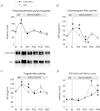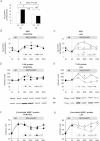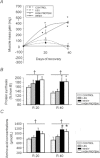Contrarily to whey and high protein diets, dietary free leucine supplementation cannot reverse the lack of recovery of muscle mass after prolonged immobilization during ageing
- PMID: 22351629
- PMCID: PMC3573319
- DOI: 10.1113/jphysiol.2011.226266
Contrarily to whey and high protein diets, dietary free leucine supplementation cannot reverse the lack of recovery of muscle mass after prolonged immobilization during ageing
Abstract
During ageing, immobilization periods increase and are partially responsible of sarcopaenia by inducing a muscle atrophy which is hardly recovered from. Immobilization-induced atrophy is due to an increase of muscle apoptotic and proteolytic processes and decreased protein synthesis. Moreover, previous data suggested that the lack of muscle mass recovery might be due to a defect in protein synthesis response during rehabilitation. This study was conducted to explore protein synthesis during reloading and leucine supplementation effect as a nutritional strategy for muscle recovery. Old rats (22–24 months old) were subjected to unilateral hindlimb casting for 8 days (I8) and allowed to recover for 10–40 days (R10–R40). They were fed a casein (±leucine) diet during the recovery. Immobilized gastrocnemius muscles atrophied by 20%, and did not recover even at R40. Amount of polyubiquitinated conjugates and chymotrypsin- and trypsin-like activities of the 26S proteasome increased. These changes paralleled an ‘anabolic resistance' of the protein synthesis at the postprandial state (decrease of protein synthesis, P-S6 and P-4E-BP1). During the recovery, proteasome activities remained elevated until R10 before complete normalization and protein synthesis was slightly increased. With free leucine supplementation during recovery, if proteasome activities were normalized earlier and protein synthesis was higher during the whole recovery, it nevertheless failed in muscle mass gain. This discrepancy could be due to a ‘desynchronization' between the leucine signal and the availability of amino acids coming from casein digestion. Thus, when supplemented with leucine-rich proteins (i.e. whey) and high protein diets, animals partially recovered the muscle mass loss.
Figures





Comment in
-
Leucine: a nutrient 'trigger' for muscle anabolism, but what more?J Physiol. 2012 May 1;590(9):2065-6. doi: 10.1113/jphysiol.2012.230631. J Physiol. 2012. PMID: 22548909 Free PMC article. No abstract available.
-
Contributions to the understanding of the anabolic properties of different dietary proteins.J Physiol. 2012 Jun 15;590(12):2839-40. doi: 10.1113/jphysiol.2012.233684. J Physiol. 2012. PMID: 22707594 Free PMC article. No abstract available.
Similar articles
-
A dietary supplementation with leucine and antioxidants is capable to accelerate muscle mass recovery after immobilization in adult rats.PLoS One. 2013 Nov 29;8(11):e81495. doi: 10.1371/journal.pone.0081495. eCollection 2013. PLoS One. 2013. PMID: 24312309 Free PMC article.
-
Unilateral hindlimb casting induced a delayed generalized muscle atrophy during rehabilitation that is prevented by a whey or a high protein diet but not a free leucine-enriched diet.PLoS One. 2013 Aug 27;8(8):e70130. doi: 10.1371/journal.pone.0070130. eCollection 2013. PLoS One. 2013. PMID: 24015173 Free PMC article.
-
The ubiquitin-proteasome and the mitochondria-associated apoptotic pathways are sequentially downregulated during recovery after immobilization-induced muscle atrophy.Am J Physiol Endocrinol Metab. 2008 Nov;295(5):E1181-90. doi: 10.1152/ajpendo.90532.2008. Epub 2008 Sep 23. Am J Physiol Endocrinol Metab. 2008. PMID: 18812460
-
Nutritional strategies to counteract muscle atrophy caused by disuse and to improve recovery.Nutr Res Rev. 2013 Dec;26(2):149-65. doi: 10.1017/S0954422413000115. Epub 2013 Aug 9. Nutr Res Rev. 2013. PMID: 23930668 Review.
-
Dietary proteins and amino acids in the control of the muscle mass during immobilization and aging: role of the MPS response.Amino Acids. 2017 May;49(5):811-820. doi: 10.1007/s00726-017-2390-9. Epub 2017 Feb 7. Amino Acids. 2017. PMID: 28175999 Review.
Cited by
-
Peripheral Amino Acid Appearance Is Lower Following Plant Protein Fibre Products, Compared to Whey Protein and Fibre Ingestion, in Healthy Older Adults despite Optimised Amino Acid Profile.Nutrients. 2022 Dec 21;15(1):35. doi: 10.3390/nu15010035. Nutrients. 2022. PMID: 36615694 Free PMC article.
-
A dietary supplementation with leucine and antioxidants is capable to accelerate muscle mass recovery after immobilization in adult rats.PLoS One. 2013 Nov 29;8(11):e81495. doi: 10.1371/journal.pone.0081495. eCollection 2013. PLoS One. 2013. PMID: 24312309 Free PMC article.
-
The mTORC1 signaling repressors REDD1/2 are rapidly induced and activation of p70S6K1 by leucine is defective in skeletal muscle of an immobilized rat hindlimb.Am J Physiol Endocrinol Metab. 2013 Jan 15;304(2):E229-36. doi: 10.1152/ajpendo.00409.2012. Epub 2012 Nov 27. Am J Physiol Endocrinol Metab. 2013. PMID: 23193052 Free PMC article.
-
Disuse-induced muscle wasting.Int J Biochem Cell Biol. 2013 Oct;45(10):2200-8. doi: 10.1016/j.biocel.2013.06.011. Epub 2013 Jun 22. Int J Biochem Cell Biol. 2013. PMID: 23800384 Free PMC article. Review.
-
Acute Sarcopenia: Mechanisms and Management.Nutrients. 2024 Oct 10;16(20):3428. doi: 10.3390/nu16203428. Nutrients. 2024. PMID: 39458423 Free PMC article. Review.
References
-
- Anthony JC, Anthony TG, Layman DK. Leucine supplementation enhances skeletal muscle recovery in rats following exercise. J Nutr. 1999;129:1102–1106. - PubMed
-
- Anthony JC, Anthony TG, Kimball SR, Vary TC, Jefferson LS. Orally administered leucine stimulates protein synthesis in skeletal muscle of postabsorptive rats in association with increased eIF4F formation. J Nutr. 2000;130:139–145. - PubMed
-
- Anthony TG, Anthony JC, Yoshizawa F, Kimball SR, Jefferson LS. Oral administration of leucine stimulates ribosomal protein mRNA translation but not global rates of protein synthesis in the liver of rats. J Nutr. 2001;131:1171–1176. - PubMed
-
- Balage M, Dardevet D. Long-term effects of leucine supplementation on body composition. Curr Opin Clin Nutr Metab Care. 2010;13:265–270. - PubMed
-
- Balage M, Averous J, Remond D, Bos C, Pujos-Guillot E, Papet I, Mosoni L, Combaret L, Dardevet D. Presence of low-grade inflammation impaired postprandial stimulation of muscle protein synthesis in old rats. J Nutr Biochem. 2009;21:325–331. - PubMed
Publication types
MeSH terms
Substances
LinkOut - more resources
Full Text Sources
Other Literature Sources
Medical

